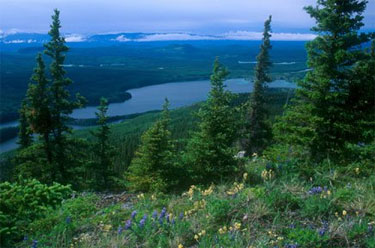Enjoying seeing the birds stop by this spring?
In large part, we can thank Canada’s vast Boreal Forest, often called North America’s bird nursery. At 1.2 billion acres, it spans the length of the country, from Alaska to Labrador.
An estimated 1 billion to 3 billion birds migrate there each spring from wintering grounds across the US and Central and South America. After breeding, their numbers swell to 3 billion to 5 billion birds – 300 species, from warblers to golden eagles, which grace our lands in the fall and winter.
That’s because this vast expanse – one of earth’s last great wilderness areas – has so many diverse habitats – thick coniferous forests, glacier-capped mountains, peatlands, and some of the world’s largest lakes, rivers, and networks of wetlands.

It teems with wildlife. Along with birds, it harbors many of the world’s last healthy populations of large predators, including grizzly bears, wolverine, timber wolves, and polar bears. It is globally-recognized as one of the world’s last strongholds for migratory mammals, particularly for herds of caribou that migrate thousands of miles each year.
"Maintaining the full complement of species, communities and ecosystem services in the Canadian Boreal Forest requires that at least half the area be protected from industrial disturbance," say researchers at the International Boreal Conservation Science Panel. Areas that have industrial activity must have the highest sustainability standards, emphasizing pristine wetlands and waterways.
This information comes from Boreal Birds Need Half, a report released this week that discusses the urgent need to protect North America’s boreal forest.
"The good news is that the boreal forest is still largely intact. The majority of birds that breed in the boreal forest still have large population sizes and are doing well," Jeff Wells, senior scientist at the Boreal Songbird Initiative and co-author of the report, told PEW Charitable Trusts. "But there are some birds-especially those breeding in the southern part of the boreal forest in Canada where there is a bigger industrial footprint-that have seen declines of 50% or more over the last 30 years."
That Brings Us to the Canadian Tar Sands
Whenever we talk about the Keystone Pipeline and the travesty of tar sands extraction, we’ve told you that it’s built on what once was the Boreal Forest.
Birds Need Half details which areas are still in-tact and where development is infringing – a prime example is tar sands extraction. Every foot it expands impinges on this great wilderness.
In Alberta, Canada, land of tar sands, just 35% of the Boreal Forest is in tact, and the government began auctioning 4200 acres to oil companies this week.

Days earlier, Environment Canada’s Committee on the Status of Endangered Wildlife in Canada released a report warning that caribou herds there face extinction.
The land being sold off is crucial caribou habitat, in addition to the many other mammals and birds. The caribou population there is down 60% in the last decade with only 515 mature animals left. Industrial development covers almost all caribou habitat in the region.
Several years ago, Manitoba protected the heart of the Boreal Forest, in accordance with the wishes of the indigenous community that is its guardian. They protected nearly two million acres, the size of Yellowstone National Park. Other important actions: protecting Great Bear Rainforest and the Canadian Boreal Forest Agreement.
Read, Birds Need Half:

This sure looks like paradise ….the world needs more air cars ..running on air not fuel..these oil company,s will not stop tearing CANADA APART until all the oil is gone …global warming is going insane…